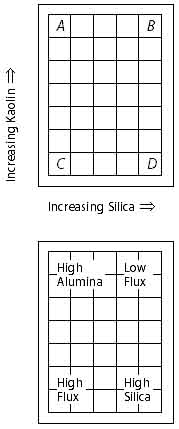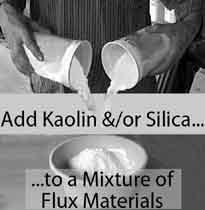|
2 Outline of |
||||||||||||||||||||||||||||||||||||
|
 |
||||||||||||||||||||||||||||||||||||
|
Outline of the Grid MethodThe 3 main variables in the base glaze are fluxes, alumina and silica. The power of this method comes from the systematic variation of these variables using a standardized and simplified experimental approach. The Standard Grid |
||||||||||||||||||||||||||||||||||||
 |
Varying Alumina and Silica: The central experimental format is the "grid"
of 35 glazes on one large tile in a 5 X 7 layout displaying 2
of the 3 main variables: In the second diagram we can see
four zones that result automatically from the way we have increased
the alumina and silica. The zone in the middle of the set can
usually be regarded as "well balanced" glazes, or in
other words, not "high" or "low" in anything.
Don't forget that all the glazes contain fluxes as well.
|
|||||||||||||||||||||||||||||||||||
Starting Point |
||||||||||||||||||||||||||||||||||||
|
An examination of these two diagrams will show that corner C has minimum alumina and silica. To understand the grid method this is where we start; the glaze in this corner is a mix of just "flux materials". We refer to Glaze C as the "Starting Point" for the set. For example it might consist of 70% feldspar plus 30% whiting. Varying Alumina and SilicaStarting in Corner C made from just flux materials we add in silica (or quartz or flint - these are all more or less pure SiO2 ) to move from left to right across the grid. We add kaolin (our source of variable Al2O3 ) to go from bottom to top. The 35 glazes are always related to each other in exactly the same way. Essentially, the kaolin and added silica percentages across the grid are the same in every set. These percentages are laid out in the Standard Recipe Grid (following). |
|||||||||||||||||||||||||||||||||||
|
The Concept: |
||||||||||||||||||||||||||||||||||||
 |
To understand the relationship between the 35 glazes, imagine this: Initially we decide on the composition of glaze 31, the starting point glaze, which is composed of 100% flux materials. We could obtain the rest of the 35 glazes in the set by adding kaolin and/or silica to Glaze 31. Therefore the flux materials don't change as kaolin and silica increase. But this is not how we actually prepare the glazes..... |
|||||||||||||||||||||||||||||||||||
|
The Method: |
||||||||||||||||||||||||||||||||||||

|
To prepare a set, we make up the 4 glazes at the corners
of the set, numbers 1, 5, 31 and 35, and blend them to
produce the rest. One set represents the "story" of the set of flux materials originally chosen for glaze 31, examining how it changes as we increase alumina and/or silica. |
|||||||||||||||||||||||||||||||||||
|
The Standard Recipe GridGlaze Recipes and Glaze Numbering: This diagram shows the recipes for each
glaze in the grid (to the nearest 1%). It also shows the standard
layout of the glaze numbers from 1 to 35. This layout does not
change.
|
||||||||||||||||||||||||||||||||||||
 |
Note the following in the Standard
Recipe Grid: Working out the Flux Material BreakupOne of the important features of this method is that the percentages in this recipe grid do not change, irrespective of the flux materials used. If the set uses only one flux material, then these are the final recipes... for ANY set. Usually however there is more than one and we have to find the breakdown of flux material. There are several easy ways of doing this, and these will be given in a later section. One Glaze Recipe Explains the Whole SetAnother result of using this approach is that all the glaze recipes can be worked out once we know the recipe for the Corner C glaze. This is a natural consequence of standardizing the method. This means the only recipe we need to record is Glaze C. From this anyone understanding the method can work out the rest of the 35 recipes if and when required. It also means that we can think of a whole set of glazes just by stating one recipe, Glaze C. We can compare whole sets of glazes one with another just by comparing the C-corner glazes; the difference between sets can be fully understood by examining the difference between the two C-glazes. This is because a particular glaze number always has the same amounts of kaolin and silica in the recipe. |
|||||||||||||||||||||||||||||||||||
|
||||||||||||||||||||||||||||||||||||
|
It is important when designing an experiment to separate
out the variables. In a two-dimensional grid format experiment
we can cope with a maximum of 2 variables - for example, silica
increasing from left to right and alumina from bottom to top.
If we decide to add colourant or opacifier to the standard grid
as outlined here, we simply add the same percentage to each of
the 35 glazes. This means that the addition of colourant or opacifier
is not a variable in this experiment of 35 glazes. Revealing Glaze PrinciplesAs well as discovering interesting glazes, the standard grid method also reveals glaze principles because wherever possible we are separating out the variables. This reveals cause and effect. For example, a glance at a fired standard grid tile reveals immediately the effect of altering alumina or silica on a given set of fluxes. Also, we can see the effect of altering fluxes by comparing the grid tiles for 2 different sets, if they have been fired on the same clay under identical firing conditions. |
|||||||||||||||||||||||||||||||||||